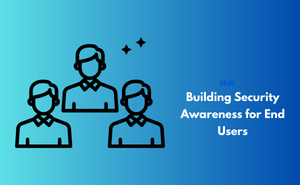👇 CELEBRATE CLOUD SECURITY DAY 👇
00
HOURS
00
MINUTES
00
SECONDS

The Building Security Awareness for End Users certification equips individuals with the knowledge to recognize and respond to cybersecurity threats. It emphasizes the role of users in preventing cyber incidents by teaching safe online behavior, secure password practices, and how to identify suspicious emails or websites. End users gain confidence in protecting themselves and their company’s digital assets.
Think of it as giving everyone in an organization a “cyber shield.” With proper training, end users can avoid common mistakes that lead to breaches, report threats effectively, and help maintain a secure workplace environment. This certification makes security a shared responsibility rather than just an IT concern.
This exam is ideal for:
Domain 1 - Introduction to Security Awareness
Domain 2 - Password and Authentication Best Practices
Domain 3 - Email and Phishing Awareness
Domain 4 - Device and Network Security
Domain 5 - Social Engineering Awareness
Domain 6 - Data Protection and Privacy
Domain 7 - Incident Reporting
Domain 8 - Safe Internet and Cloud Practices
Domain 9 - Continuous Security Habits
Industry-endorsed certificates to strengthen your career profile.
Start learning immediately with digital materials, no delays.
Practice until you’re fully confident, at no additional charge.
Study anytime, anywhere, on laptop, tablet, or smartphone.
Courses and practice exams developed by qualified professionals.
Support available round the clock whenever you need help.
Easy-to-follow content with practice exams and assessments.
Join a global community of professionals advancing their skills.
Using secure, encrypted networks ensures that sensitive data is protected from interception. End users need to understand the importance of avoiding public Wi-Fi for sensitive transactions, using VPNs (Virtual Private Networks), and adhering to organization-specific network security policies to avoid security risks
Physical security involves safeguarding devices from theft or unauthorized access. End users should be aware of practices like locking screens when not in use, securing laptops in public spaces, and reporting lost or stolen devices immediately to maintain the organization's security.
Improper disposal of data, such as deleting files without properly wiping them, can lead to data breaches. End users must understand how to securely delete sensitive information using tools that ensure files are permanently destroyed, thus preventing unauthorized recovery.
With the rise in cyber threats, organizations are increasingly prioritizing employee cybersecurity training. The demand for professionals who can design and deliver engaging security awareness programs is growing. This includes creating content that helps end users understand complex cybersecurity concepts in simple terms.
Jobs in cybersecurity training, awareness program development, and security consulting are in high demand. Roles such as Security Awareness Specialist, IT Security Trainer, and Cybersecurity Consultant require individuals who can effectively communicate security best practices to non-technical employees.
Proper security training reduces the risk of human error leading to security breaches. It improves employee vigilance, decreases the likelihood of security incidents, and ensures that staff are prepared to respond appropriately to potential threats, ultimately safeguarding the organization’s assets and reputation
End users should look for suspicious signs such as unfamiliar email addresses, poor grammar, urgent or threatening language, and unexpected attachments or links. They should verify the sender's identity and avoid clicking on links or downloading attachments from untrusted sources.
By creating strong, unique passwords and using multi-factor authentication (MFA), end users protect their accounts and systems from unauthorized access. Password security is one of the most effective ways to prevent data breaches and cyber-attacks.
Building security awareness for end users is crucial because individuals are often the weakest link in cybersecurity. Providing training on identifying threats like phishing, securing passwords, and practicing safe internet habits helps prevent data breaches, malware infections, and other cyber-attacks. End-user education is essential for maintaining an organization's overall cybersecurity posture.
Key skills include recognizing phishing and social engineering attempts, understanding the importance of password management, safe browsing practices, data protection, and secure use of mobile devices and networks. Knowledge of malware threats and how to identify suspicious activities also plays a critical role.